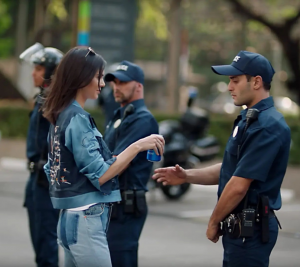By Lacie C. Blankenship
At a time when people walk around with digital access all day, every day, brands are trying harder than ever to create memorable marketing campaigns that resonate with consumers and don’t get lost in the mix. However, when these efforts go poorly, the damage can be significant. Cringeworthy marketing moves can lead to significant consumer backlash, damaging brand reputation and brand equity.
A new paper, co-authored by Anthony Salerno (Vanderbilt University), Brianna Escoe (Louisiana State University), and Nathanael Martin (University of Cincinnati), explores the concept of cringe, how consumers respond to the emotion, and its impact on brand reputation.
“People want to support brands they align with, and understanding cringe helps marketers build stronger connections with consumers and avoid a reputation crisis,” says Salerno.
What is cringe in marketing?
Cringe occurs when people feel secondhand embarrassment for someone else after observing an awkward attempt to make a good impression. People cringe when someone (or some brand) is trying too hard, tone-deaf, and in some way violating social norms or expectations. The result is discomfort, disbelief, and sometimes judgment. “I can’t believe they thought that was a good idea” is a sentiment that often follows witnessing something cringeworthy.
Cringeworthy marketing occurs when brands make a failed attempt to connect with consumers by attempting to appear relevant, humorous, or socially conscious. Cringeworthy brand content is most often an advertisement, but can include all forms of content, even information about employees and influencers. Brands associated with anything cringeworthy have the potential to elicit powerful consumer reactions and significantly damage brand reputation, like Tesla’s recent decline amid Elon Musk backlash.
Cringeworthy campaigns that went viral

Photo from Pepsi advertisement featuring Kendall Jenner handing a police officer a can, via The New York Times, published April 5, 2017.
Pepsi’s “Live for Now” ad fail, 2017
Pepsi’s 2017 “Live for Now” campaign, which featured Kendall Jenner joining a protest, implied that sharing a Pepsi with police could resolve racial tension in America. The intended message behind the advertisement was to promote unity, but it ended up being perceived as a tone-deaf exploitation. Following the release of the advertisement, Pepsi’s online mentions increased significantly (over 21,000%) and were overwhelmingly negative; Pepsi pulled the ad within 24 hours, resulting in nearly $100 million in lost production costs and media spending. Although eight years have passed since the commercial aired, people are still cringing over it, and it’s a case study of what not to do in advertising.
Peloton’s “The Gift That Gives Back” ad fail, 2019
Peloton’s 2019 campaign, “The Gift That Gives Back,” featured a husband gifting his wife a Peloton bike for Christmas and then her following yearlong fitness journey. The ad ignited conversations on social media, calling it cringeworthy for being insensitive and sexist. Subsequently, Peloton’s stock price fell by over 10% and its market capitalization by over a billion dollars.
The cost of cringe: How consumer perception impacts brand reputation
Cringeworthy marketing campaigns illustrate that it’s not only important that people talk about your brand, but also vital that what they’re saying is positive. So, that old saying “all press is good press” definitely doesn’t apply when cringe is involved. Regardless of the intentions, if an audience cringes, significant consumer backlash may cause long-term damage to brand reputation, ultimately impacting revenue. With the Pepsi and Peloton examples, it’s clear that a marketing misstep in the form of cringeworthy ads is a costly mistake.
Why does cringeworthy advertising go viral?
In an era of screenshots and screen recording, when going viral goes wrong, social media and group chats turn marketing missteps into cultural touchpoints almost overnight. But what makes cringeworthy campaigns so shareable?
“One of the main findings of our paper is that cringeworthy content drives word of mouth,” says Escoe. “When content is released from a brand and is deemed cringeworthy by consumers, they talk about it with each other, and it leads to a huge viral response.”
Many marketers find virality tempting, but in the case of cringeworthy content, researchers find consumers are quick to judge and blame brands. For example, Subway released a cringeworthy commercial with Russell Wilson that went viral. The commercial was the punchline of many memes, and Subway ended up pulling the advertisement and the sandwich off of menus.
“So yes, while cringeworthy content does drive virality and gets your name out there, we find that the majority of the sentiment around this is actually negative,” says Escoe.
The researchers find that sharing cringeworthy content is compelling because it’s perceived as an opportunity for self-enhancement. The mindset is, “Look what they did, I would never do that!” This dynamic plays out across all media, from influencer posts and ads to tone-deaf executives. The authors call it a form of social currency, a way for people to elevate themselves at the expense of a brand.
“While advertising fails tend to go viral, it’s rarely favorable for brands. Virality likely isn’t worth the risk of what cringe can do to a reputation,” says Salerno.
How should brands respond to cringe backlash?
The researchers shared advice on how brands should respond to cringe backlash, whether they’re on the offending side or if a competitor is in the negative light.
“Cringe can be contagious when consumers talk about a brand for all the wrong reasons,” says Martin. “It’s important that brands listen to feedback and respond quickly.”
Consider a timely and sincere apology
When consumers cringe at a brand, they should consider apologizing quickly and sincerely. Being authentic, owning mistakes, and acknowledging consumer voices are key.
Take note for the future
Regardless of whether a brand feels an apology is necessary, it is important to note the backlash and explore where people are coming from. This approach can help brands better understand what they should be more mindful of, and it may even inspire new campaigns that reinforce core values.
Seize the moment

Photo is a screenshot of a post from Olipop’s X account.
If consumers are cringing at the competition, brands have a unique opportunity to capitalize and seize the moment. One example is Olipop’s recent campaign that followed a cringeworthy marketing move from their rival, Poppi. Poppi sent vending machines to influencers, triggering criticism for being extravagant. Olipop responded with, “For the record, those machines cost $25K each lol,” and “We don’t have vending machines, but who wants a jersey!!” In doing so, Olipop won over new fans and reinforced its social standing.
How can brands prevent cringeworthy marketing mistakes?
While there is a saving grace for brands that release cringeworthy content: a loyal consumer base, which is less likely to negatively talk about the brand or reshare anything cringeworthy, it’s best practice for brands to remain proactive in managing their brand reputation.
Engage in social listening before, during, and after a campaign
Ensuring that brands know the appropriate way to participate in conversations is extremely important. This is especially true when marketing materials reference pop culture or target younger consumers, where trends change fast, and it’s easy to miss the mark. Likewise, it’s even more important when a brand feels the need to discuss social causes.
Testing & prioritizing diversity of thought
It is good practice for brands to test consumer reactions before fully releasing advertisements. Likewise, prioritizing diversity of thought is really important for marketing teams through ideation, development, and testing. Having one person with a different perspective can stop a cringeworthy disaster before it leaves the conference room.
Academic research & real-world impact

Professor Anthony Salerno
The paper “That’s So Cringeworthy! Understanding What Cringe Is and Why We Want to Share It” explores the relationship between cringe, consumer behavior, and brand reputation through six studies. The findings help explain consumer chatter across social media platforms. For marketers, this research offers insight into the line between bold messaging and brand-damaging awkwardness and tone-deafness.
“This study underscores the importance of marketers staying in touch with their brand’s audience and considering different perspectives while creating marketing campaigns,” the researchers say.
About the research
“That’s So Cringeworthy! Understanding What Cringe Is and Why We Want to Share It” was co-authored by Anthony Salerno, Associate Professor of Marketing at Vanderbilt Business, Brianna Escoe, Assistant Professor of Marketing at Louisiana State University, and Nathanael Martin, Assistant Professor of Marketing at the University of Cincinnati. The paper is forthcoming publication in the Journal of Marketing Research, and can be accessed digitally.
Editor’s Note: This article was originally published in the print edition of Vanderbilt Business Magazine in Summer 2023. The digital article was updated on June 3, 2025.